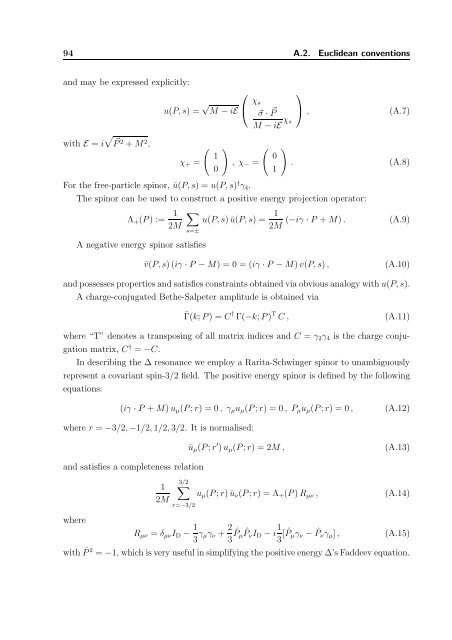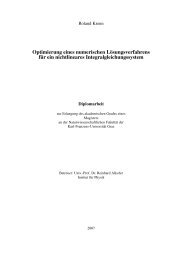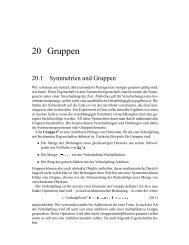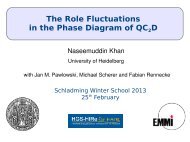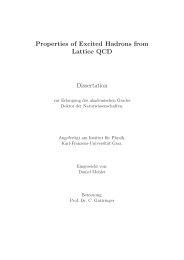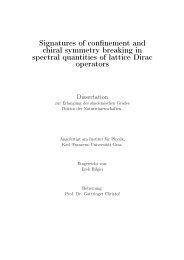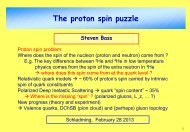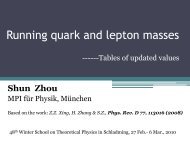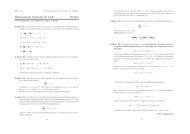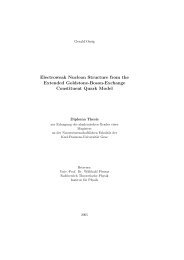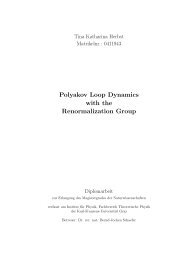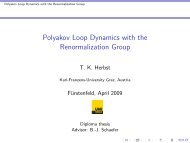The QCD Quark Propagator in Coulomb Gauge and - Institut für Physik
The QCD Quark Propagator in Coulomb Gauge and - Institut für Physik
The QCD Quark Propagator in Coulomb Gauge and - Institut für Physik
Create successful ePaper yourself
Turn your PDF publications into a flip-book with our unique Google optimized e-Paper software.
94 A.2. Euclidean conventions<br />
<strong>and</strong> may be expressed explicitly:<br />
u(P, s) = √ M − iE<br />
⎛<br />
⎝ χ s<br />
⃗σ · ⃗P<br />
M − iE χ s<br />
⎞<br />
⎠ ,<br />
(A.7)<br />
with E = i√ ⃗P 2<br />
+ M 2 ,<br />
χ + =<br />
(<br />
1<br />
0<br />
)<br />
, χ − =<br />
For the free-particle sp<strong>in</strong>or, ū(P, s) = u(P, s) † γ 4 .<br />
(<br />
0<br />
1<br />
)<br />
. (A.8)<br />
<strong>The</strong> sp<strong>in</strong>or can be used to construct a positive energy projection operator:<br />
Λ + (P) := 1 ∑<br />
u(P, s) ū(P, s) = 1 (−iγ · P + M) .<br />
2M<br />
2M (A.9)<br />
s=±<br />
A negative energy sp<strong>in</strong>or satisfies<br />
¯v(P, s) (iγ · P − M) = 0 = (iγ · P − M) v(P, s) ,<br />
(A.10)<br />
<strong>and</strong> possesses properties <strong>and</strong> satisfies constra<strong>in</strong>ts obta<strong>in</strong>ed via obvious analogy with u(P, s).<br />
A charge-conjugated Bethe-Salpeter amplitude is obta<strong>in</strong>ed via<br />
¯Γ(k; P) = C † Γ(−k; P) T C ,<br />
(A.11)<br />
where “T” denotes a transpos<strong>in</strong>g of all matrix <strong>in</strong>dices <strong>and</strong> C = γ 2 γ 4 is the charge conjugation<br />
matrix, C † = −C.<br />
In describ<strong>in</strong>g the ∆ resonance we employ a Rarita-Schw<strong>in</strong>ger sp<strong>in</strong>or to unambiguously<br />
represent a covariant sp<strong>in</strong>-3/2 field. <strong>The</strong> positive energy sp<strong>in</strong>or is def<strong>in</strong>ed by the follow<strong>in</strong>g<br />
equations:<br />
(iγ · P + M) u µ (P; r) = 0 , γ µ u µ (P; r) = 0 , P µ u µ (P; r) = 0 ,<br />
(A.12)<br />
where r = −3/2, −1/2, 1/2, 3/2. It is normalised:<br />
ū µ (P; r ′ ) u µ (P; r) = 2M ,<br />
(A.13)<br />
<strong>and</strong> satisfies a completeness relation<br />
where<br />
1<br />
2M<br />
3/2<br />
∑<br />
r=−3/2<br />
u µ (P; r) ū ν (P; r) = Λ + (P) R µν ,<br />
R µν = δ µν I D − 1 3 γ µγ ν + 2 3 ˆP µ ˆPν I D − i 1 3 [ ˆP µ γ ν − ˆP ν γ µ ] ,<br />
(A.14)<br />
(A.15)<br />
with ˆP 2 = −1, which is very useful <strong>in</strong> simplify<strong>in</strong>g the positive energy ∆’s Faddeev equation.


